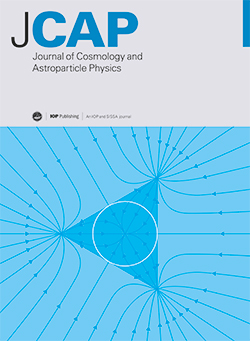LiteBIRD science goals and forecasts: constraining isotropic cosmic birefringence
IF 5.3
2区 物理与天体物理
Q1 ASTRONOMY & ASTROPHYSICS
Journal of Cosmology and Astroparticle Physics
Pub Date : 2025-07-24
DOI:10.1088/1475-7516/2025/07/083
引用次数: 0
Abstract
Cosmic birefringence (CB) is the rotation of the photons' linear polarisation plane during propagation. Such an effect is a tracer of parity-violating extensions of standard electromagnetism and would probe the existence of a new cosmological field acting as dark matter or dark energy. It has become customary to employ cosmic microwave background (CMB) polarised data to probe such a phenomenon. Recent analyses on Planck and WMAP data provide a hint of detection of the isotropic CB angle with an amplitude of around 0.3° at the level of 2.4 to 3.6σ. In this work, we explore the LiteBIRD capabilities in constraining such an effect, accounting for the impact of the more relevant systematic effects, namely foreground emission and instrumental polarisation angles. We build five semi-independent pipelines and test these against four different simulation sets with increasing complexity in terms of non-idealities. All the pipelines are shown to be robust and capable of returning the expected values of the CB angle within statistical fluctuations for all the cases considered. We find that the uncertainties in the CB estimates increase with more complex simulations. However, the trend is less pronounced for pipelines that account for the instrumental polarisation angles. For the most complex case analysed, we find that LiteBIRD will be able to detect a CB angle of 0.3° with a statistical significance ranging from 5 to 13σ, depending on the pipeline employed, where the latter uncertainty corresponds to a total error budget of the order of 0.02°.LiteBIRD科学目标和预测:约束各向同性宇宙双折射
宇宙双折射(CB)是光子在传播过程中线性偏振平面的旋转。这种效应是标准电磁学违反宇称扩展的示踪剂,并将探测作为暗物质或暗能量的新宇宙场的存在。利用宇宙微波背景(CMB)极化数据来探测这种现象已经成为惯例。最近对普朗克和WMAP数据的分析提供了在2.4 ~ 3.6σ水平上探测到振幅约为0.3°的各向同性CB角的线索。在这项工作中,我们探索了LiteBIRD在限制这种效应方面的能力,考虑了更相关的系统效应,即前景发射和仪器偏振角的影响。我们构建了五个半独立的管道,并针对四个不同的模拟集进行测试,这些模拟集在非理想性方面增加了复杂性。对于所考虑的所有情况,所有管道都显示出鲁棒性,能够在统计波动范围内返回CB角的期望值。我们发现,随着模拟越复杂,估算CB的不确定性也随之增加。然而,对于考虑仪器极化角度的管道来说,这种趋势就不那么明显了。对于所分析的最复杂的情况,我们发现LiteBIRD将能够检测到0.3°的CB角,其统计显著性范围为5到13σ,这取决于所采用的管道,其中后者的不确定性对应于0.02°数量级的总误差预算。
本文章由计算机程序翻译,如有差异,请以英文原文为准。
求助全文
约1分钟内获得全文
求助全文
来源期刊

Journal of Cosmology and Astroparticle Physics
地学天文-天文与天体物理
CiteScore
10.20
自引率
23.40%
发文量
632
审稿时长
1 months
期刊介绍:
Journal of Cosmology and Astroparticle Physics (JCAP) encompasses theoretical, observational and experimental areas as well as computation and simulation. The journal covers the latest developments in the theory of all fundamental interactions and their cosmological implications (e.g. M-theory and cosmology, brane cosmology). JCAP''s coverage also includes topics such as formation, dynamics and clustering of galaxies, pre-galactic star formation, x-ray astronomy, radio astronomy, gravitational lensing, active galactic nuclei, intergalactic and interstellar matter.
 求助内容:
求助内容: 应助结果提醒方式:
应助结果提醒方式:


